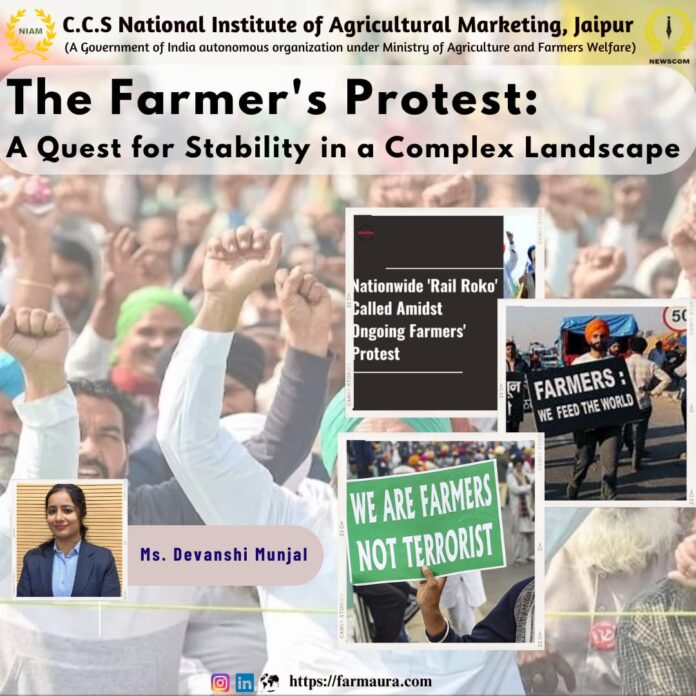The Farmer’s Protest: A Quest for Stability in a Complex Landscape
The ongoing farmer’s protest in India has reignited a crucial conversation about the challenges plaguing the nation’s agricultural sector. At the heart of the movement lies the demand for a legally guaranteed Minimum Support Price (MSP), a system intended to ensure a baseline price for essential agricultural commodities. However, the debate surrounding the implementation of MSP is multifaceted, necessitating a balanced approach that acknowledges the concerns of both farmers and policymakers.
Problem and Context:
India’s agricultural sector, despite contributing significantly to the nation’s food security, faces numerous challenges. These include:
- Declining real incomes: While agriculture employs nearly half of India’s workforce, its contribution to the GDP has shrunk to less than 18%, leading to a decline in farmers’ real incomes.
- Rising indebtedness: Many farmers grapple with significant debt burdens, making them vulnerable to exploitation by middlemen and market fluctuations.
- Skewed terms of trade: Farmers often receive a lower share of the final consumer price for their produce, creating an imbalance in the agricultural value chain.

Source : Indian Express
Swaminathan Commission Formula: Farmers are demanding a legal guarantee for MSP based on the Swaminathan Commission formula, which proposes C2 + 50% as the minimum price.
- C2: This cost of production (CoP) includes:
- A2: Paid-out cash and kind expenses incurred by farmers (seeds, fertilizers, labor, etc.)
- FL: Imputed value of unpaid family labor
- Additional costs:
- Interest on owned capital assets
- Rent for leased land or rental value of owned land
- 50%: This represents a mark-up over the CoP to ensure a reasonable profit for farmers.
Current vs. Swaminathan MSP: The government currently sets MSP based on A2 + FL, leading to lower prices compared to the Swaminathan Commission formula that considers additional costs.

Source : Hindustan Times
Other Demands: While the legal guarantee for MSP is the key demand, farmers also seek:
- Pension for farmers and farm laborers
- Farm debt waivers
- Compensation for families of deceased farmers
The demand for a legal guarantee for MSP stems from these very challenges. Farmers believe that a guaranteed minimum price would provide them with some financial stability and protection against volatile market forces.
Arguments for and Against:
Proponents of legalizing MSP argue that it would:
- Ensure a minimum income: This would provide a safety net for farmers, especially during periods of low market prices.
- Incentivize crop diversification: Knowing a guaranteed price could encourage farmers to cultivate a wider range of crops, promoting dietary diversity and environmental sustainability.
- Bolster rural economies: Increased income for farmers could stimulate economic activity in rural areas.
Opponents, however, raise concerns about the feasibility and potential drawbacks of legalizing MSP for all crops:
- Financial burden: The government estimates that guaranteeing MSP for all crops could cost up to ₹40 lakh crore annually, putting a significant strain on public finances.
- Market distortion: Critics argue that artificially setting minimum prices could distort market dynamics, leading to inefficiencies and reduced private sector investment.
- Logistical challenges: Efficient procurement and storage of a wider range of crops across the vast Indian landscape presents logistical and infrastructural challenges.
A Balanced Perspective:
The complexities surrounding the MSP issue necessitate a nuanced approach that goes beyond simply legalizing or rejecting it entirely. Here are some potential solutions:
- Focus on existing MSP crops: Strengthening the procurement system for rice and wheat, the crops currently covered under MSP, to ensure farmers receive the guaranteed price effectively.
- Explore alternative support mechanisms: Considering direct income support schemes or crop insurance programs as alternatives to MSP for certain crops.
- Promoting market reforms: Encouraging contract farming and improving market access for farmers to reduce dependence on middlemen and ensure better price realization.
- Investing in agricultural research and development: This could lead to increased productivity and improved market competitiveness for farmers.
Conclusion:
The farmer’s protest highlights the urgent need for comprehensive reforms in India’s agricultural sector. While the demand for a legal guarantee for MSP reflects the legitimate concerns of farmers, a one-size-fits-all approach is unlikely to be the most viable solution. A collaborative effort involving farmers, policymakers, agricultural scientists, and market experts is crucial to develop a sustainable and equitable future for Indian agriculture. This future should ensure not only fair prices for farmers but also increased productivity, market efficiency, and long-term food security for the nation.





Explained very well. Insightful.